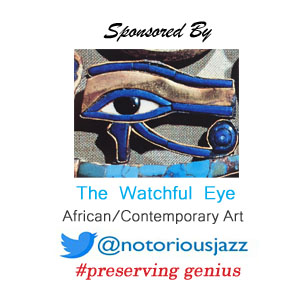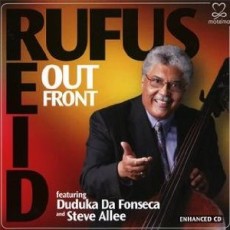
Daily Dose Of Jazz…
Rufus Reid was born on February 10, 1944 in Atlanta, Georgia but was raised in Sacramento, California where he played the trumpet through junior high and high school. Shortly after graduation he entered the Air Force and it was there that he became seriously interested in the bass.
Following his honorable discharge from the military, Reid moved to Seattle to begin studies with James Harnett of the symphony. Then continued at Northwestern University graduating with a music degree as a performance major on double bass.
His professional career began in Chicago playing with Sonny Stitt, James Moody, Milt Jackson, Curtis Fuller and Dizzy Gillespie, recording with Kenny Dorham, Dexter Gordon, Lee Konitz and Howard McGhee, and touring internationally with the Hutcherson-Land quintet, Freddie Hubbard, Nancy Wilson, Eddie Harris and Dexter Gordon in the ‘70s. Moving to New York in 1976 he began playing and recording with Thad Jones & Mel Lewis who are just the few colleagues among the hundreds of world’s greatest musicians.
A prolific bassist, Reid has spanned generations of jazz appearing on countless hard bop, bebop, swing and pop sessions with his restrained yet emphatic tone, time, harmonic sensibility and has made him one of the most sought after bassists in the industry. He has co-led a group with Akira Tana called TanaReid since the late eighties.
Rufus Reid began teaching at William Patterson College in 1979 and the bassist, educator and composer continues to record and perform around the world.
More Posts: bass
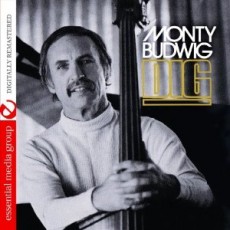
Daily Dose Of Jazz…
Monty Rex Budwig was born on December 26, 1926 in Pender, Nebraska. He began playing bass during high school, gigged with Vido Musso in 1951 and continued in the military band while in the Air Force.
In 1954 he moved to Los Angeles and became a sought after bassist in the West Coast jazz scene. He played with Barney Kessel and The Red Norvo Trio when he arrived followed by stints with Zoot Sims and the Woody Herman Orchestra. Budwig soon became a studio fixture, recording and performing as a sideman on countless sessions with many notable jazz musicians such as Carmen McRae, Barney Kessel, Woody Herman, Red Norvo, Bob Cooper, Scott Hamilton, Bud Shank, Shelly Manne and the Lighthouse All Stars.
Best known for his melodic solos and his ability to swing a band, Monty was highly regarded for playing with Vince Guaraldi, but there has been some question as to whether or not he was the bassist heard on the Charlie Brown Christmas Album. He released one recording as a leader titled “Dig” on the Concord label that included his wife Arlette McCoy on electric piano. Double bassist Monty Budwig passed away on March 9, 1992.
More Posts: bass
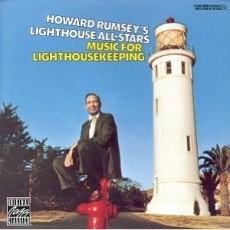
Daily Dose Of Jazz…
Howard Rumsey was born on November 7, 1917 in Brawley, California and first began playing the piano, followed by the drums and finally the bass. After jobs with Vido Musso and Johnnie Davis, he became part of Stan Kenton’s first band. After an argument ensued he left Kenton and played with Charlie Barnet and Barney Bigard before taking a short hiatus from music.
Upon his return Howard hit the Los Angeles jazz scene and formed the Lighthouse All-Stars. For most of the 1950s this group played each Sunday at the Lighthouse Cafe in Hermosa Beach. During its lifetime, the Lighthouse All-Stars were one of the primary modern jazz institutions on the West Coast that provided a home for many Los Angeles musicians. He opened his debut show on May 29, 1949 to immediate success.
Rumsey employed in the first Lighthouse All-Stars group the Los Angeles musicians who had been a part of the Central Avenue scene in the 1940s, including Teddy Edwards, Sonny Criss, Hampton Hawes, Frank Patchen, Bobby White and Keith Williams. His second band featured a new wave of players, Jimmy Giuffre, Shorty Rogers, and Shelly Manne. The success of this group soon had them recording for Les Koenig’s Contemporary Records. This contract expanded to include many of the members of the group leading sessions for this same label, such as Art Pepper and Stan Getz.
This third edition of the Lighthouse All-Stars included Bud Shank, Bob Cooper, Rolf Ericsson and Max Roach. This band took part in a historic recording in 1953 that featured both Chet Baker and Miles Davis, along with Russ Freeman and Lorraine Geller.
Various editions of the band hosted other players until the early Sixties when jazz interest faded in Los Angeles, but during its heyday some seventy-five musicians came through their ranks until the group eventually dissolved. From 1971 to 1985 he owned and operated the 200 seat club Concerts by the Sea in Redondo Beach, California.In 2005 the film Jazz on the West Coast: The Lighthouse was released about the group. Double-bassist Howard Rumsey passed away on July 15, 2015 from complications of pneumonia in Newport Beach, California, at the age of 96.
More Posts: bass
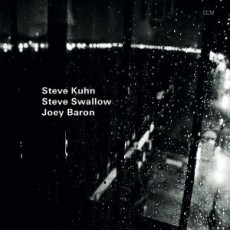
Daily Dose Of Jazz…
Steve Swallow was born on October 4, 1940 in Fair Lawn, New Jersey. As a child he studied piano and trumpet before turning to the double bass at age 14. While attending a prep school, he began trying his hand in jazz improvisation. In 1960 he left Yale, settled in New York City and played with Jimmy Giuffre’s trio with Paul Bley.
After joining Art Farmer’s quartet in 1964, Swallow began to write. It is in the 1960s that his long-term association with Gary Burton’s various bands began. The early 1970s saw him switch exclusively to electric bass guitar, preferring the 5-string.
Steve became an educator in 1974 for two years teaching at the Berklee School of Music. In ‘78 he became an essential and constant member of Carla Bley’s band, toured extensively with John Scofield in the early 1980s, has returned to this collaboration several times over the years.
Bassist Steve Swallow has consistently won the electric bass category in Down Beat magazine’s Critics and Readers yearly polls since the mid-80s. Having grown a catalogue of some five-dozen albums as a leader and sideman, he continues to compose, perform and record.
More Posts: bass
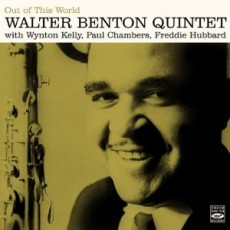
Daily Dose Of Jazz…
Walter Benton was born September 9, 1930 in Los Angeles, California and first began playing saxophone as in high school. After three years of service in the Army in the early 1950s, he played in 1954 with Kenny Clarke, Max Roach and Clifford Brown.
From 1954 to 1957 he played Afro-Latin jazz with Perez Prado, touring Asia with the band. Returning to the States, he went on to work with Quincy Jones in 1957 and Victor Feldman in 1958-59. He led his own group from 1959, recording under his own name in 1960 with Freddie Hubbard, Wynton Kelly, Paul Chambers and Tootie Heath.
That same year he worked again with Max Roach and Julian Priester. In 1961 he recorded with Abbey Lincoln, Roach once more, Eric Dolphy and Slide Hampton. By the late 1960s he was working with Gerald Wilson and John Anderson.
As so often happens with great players, in the late 60’s Benton became discouraged with the state of jazz and the overall music business, disappeared from the scene, sank into poverty never re-discovered. He stopped playing and lived the rest of his days in cheap rooming houses and collected a pittance of social assistance.
On August 14, 2000, West Coast tenor saxophonist Walter Benton, who played cool and bluesy, ventured into free and wild before returning to his roots with his beautiful dark and somewhat diffused sound coupled with his own ideas and phrasing, passed away in total obscurity in Los Angeles at the age of 69.
More Posts: saxophone



